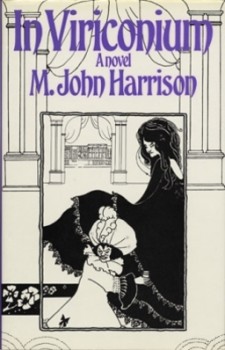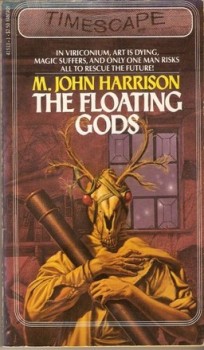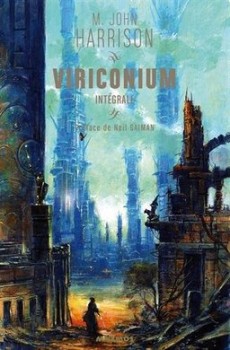In Viriconium by M. John Harrison
 And so we come to the end of M. John Harrison’s trilogy of novels set in the far, far future of our world. For In Viriconium (1982) Harrison drops almost all elements of heroic fantasy in presenting the story of the artist Ashlyme. Ashlyme’s effort to rescue another artist, the reclusive Audsley King, from a plague outbreak is set against the antics of two manic deities. Woven through the novel are characters and clues that tie it to the previous two, The Pastel City and A Storm of Wings (reviewed at the links). Some build on the earlier stories while others seem to deconstruct and reconfigure them.
And so we come to the end of M. John Harrison’s trilogy of novels set in the far, far future of our world. For In Viriconium (1982) Harrison drops almost all elements of heroic fantasy in presenting the story of the artist Ashlyme. Ashlyme’s effort to rescue another artist, the reclusive Audsley King, from a plague outbreak is set against the antics of two manic deities. Woven through the novel are characters and clues that tie it to the previous two, The Pastel City and A Storm of Wings (reviewed at the links). Some build on the earlier stories while others seem to deconstruct and reconfigure them.
The Low City, the poorer section of Viriconium and the one most given over to decay, has been struck by a strange malady:
The plague is difficult to describe. It had begun some months before. It was not a plague in the ordinary sense of the word. It was a kind of thinness, a transparency. Within it people aged quickly, or succumbed to debilitating illnesses — phthisis, influenza, galloping consumption. The very buildings fell apart and began to look unkempt, ill-kept. Businesses failed. All projects dragged out indefinitely and in the end came to nothing.
Day by day it is spreading, restricting travel in and out of a growing portion of the Low City. Hidden away in her rooms above the Rue Serpolet, Audsley King remains the most famous and sought after artist in Viriconium. Even as the plague pares away the substance and people of the city, her agent, Paulinus Spack, is hoping to produce a new play with sets designed by her. All across the High City, Viriconium’s wealthy district, patrons are itching to invest in something featuring King’s creations. She, for that to happen, must leave the Low City — but she does not wish to. In addition to her acceptance of eventual death from the plague, she is repulsed by her potential benefactors:
“Besides,” she said, “I would not go if they did. Why should I go? The High City is an elaborate catafalque. Art is dead up there, and Paulinus Rack is burying it. Nothing is safe from him — or from those old women who finance him — painting, theater, poetry, music. I no longer wish to go there.” Her voice rose. “I no longer wish them to buy my work. I belong here.”
Spurred by a desire to save one of Viriconium’s most important figures, Ashlyme agrees to convince King to flee to the High City. If she cannot be convinced he will, with the help of the astronomer Emmet Buffo, kidnap her and bring her out anyway.
In the course of visiting King, Ashlyme comes into contact with Viriconium’s two resident deities, the Barley Brothers. They first appeared in the sky above the city decades earlier, decked out in scarlet armor and riding white stallions. Now they stumble around the city’s streets dressed in “outlandish clothes” “covered with food stains and worse.” They drink, vomit copiously, and jabber in a mix of doggerel and 20th century English slang. Ashlyme is unable to prevent them from always popping up around him, although they never do more than disgust him with their antics.
 The Barley Brothers’ dwarfish assistant, the Grand Cairo, paranoid that they have some terrible plan in store for him, turns his attention to Ashlyme. As commander of the police responsible for containing the plague, he presents himself as a real threat to the artist should Ashlyme not reveal everything he learns about the Barley Brothers.
The Barley Brothers’ dwarfish assistant, the Grand Cairo, paranoid that they have some terrible plan in store for him, turns his attention to Ashlyme. As commander of the police responsible for containing the plague, he presents himself as a real threat to the artist should Ashlyme not reveal everything he learns about the Barley Brothers.
The great theme of In Viriconium is despair. The city and its citizens are being devoured by sickness for which there is no cure. Though thought contained, it isn’t — spreading its ill-effects to every aspect of Viriconium. No plans are able to reach fruition. Ashlyme’s plot to rescue King from herself fails horribly. The preparations for theater productions drag on endlessly, with no actors ever mounting the stage.
Art offers no consolation, its creators having been co-opted by the wealthy. Wealth itself proves unable to buy lasting comfort, instead bleaching the life out of what it acquires.
Harrison continues his demolition of standard genre fantasy worldbuilding. Viriconium feels like a very different city than it did in either The Pastel City or A Storm of Wings. It might just be we are seeing through an artist’s eye instead of a hero’s or a killer’s. It also might be that the city has changed because its creator has a different plan for it this time around, serving as the backdrop for a different sort of story.
Characters from the earlier books reappear in In Viriconium. Or not. When an old man who can’t remember how old he is produces a metal feather, it’s easy to assume he’s the inventor Cellur, but it’s never made clear. The history of the Barley Brothers as told by the Grand Cairo echoes the plot of A Storm of Wings, but is it a retelling of those events or only a delusion on his part? They might be Resurrected Men or they might really be gods.
Harrison draws the reader into Viriconium — for example into suspecting along with the characters that the world is controlled by a fortune teller’s tarot-like cards — then startles him with reminders that the world is an artful construct; just words on a page. Story and world fold in on themselves, proving they really are no more than a game being played by their author.
 Harrison calls these books a metafictional critique and deconstruction of “epic” fantasy. In epic fantasy heroes move the world, right wrongs, and vanquish their enemies, but in In Viriconium there are no straightforward answers or bold heroes. What little agency the characters have in the first two books is mostly stripped away in this one. Hope is offered in the end, but it is a hard one that involves destruction as much as construction.
Harrison calls these books a metafictional critique and deconstruction of “epic” fantasy. In epic fantasy heroes move the world, right wrongs, and vanquish their enemies, but in In Viriconium there are no straightforward answers or bold heroes. What little agency the characters have in the first two books is mostly stripped away in this one. Hope is offered in the end, but it is a hard one that involves destruction as much as construction.
Harrison’s prose has grown in beauty and intricacy with each book. The Pastel City was written in a typical genre style. In A Storm of Wings, as the greater story Harrison was telling became more complex, so did his writing. Finally, here in In Viriconium, writing about despondency and art, it became a thing of great beauty. For example, Ashlyme is described as a painter who “first put his sitter’s soul in the killing bottle, then pinned it out on the canvas for everyone to look at like a broken moth.” I leave it to new readers to discover it for themselves and revel in its often intoxicating power.
In Viriconium jettisons the trappings of swords & sorcery that the trilogy used to build its own foundation. By maintaining its ties to the earlier books through reuse of characters and narrative elements, it manages to hold a valuable conversation about the genre. As with the other books, I don’t agree with all of Harrison’s arguments — for one, I believe there is value and truth to stories about heroics — but they are important to have.
Next week: Vircionium Knights, the final volume in the series. Unlike the first three books, it’s a collection of short stories.
Fletcher Vredenburgh reviews here at Black Gate most Tuesday mornings and at his own site, Stuff I Like when his muse hits him. Right now, he’s writing about Western movies.
I added this to my must read list on Goodreads not more than two weeks ago. I’m going to have to bump this up in the queue.
@Zhern – the interesting thing is, while I think it helps to read them in order, it doesn’t really matter. Fantastic set of books that I’m quite glad I’ve finally read.